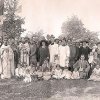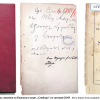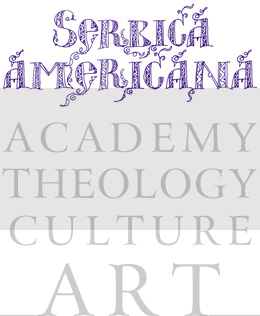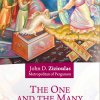РЕТКО ИЗДАЊЕ У БИБЛИОТЕЦИ САНУ
Сања Степановић Тодоровић, ПОЛИТИКА, 29. новембар 2014.
О овом издању су 1. септембра 1869. године известиле новине “Alaska Herald”, које су иначе објављивале текстове на енглеском и руском језику, а чији је власник био Украјинац. Тамо се, међу осталим, каже: "Недавно је објављена књига у овом граду, на славенском језику, под називом “Sloboda”, посвећена Николи I, славенском кнезу Црне Горе. Аутор описује и хвали отменост и образованост велике славенске расе у Америци"
Најзначајнији догађаји у формирању националноr и културног идентитета српских исељеника на америчком континенту десили су се у Калифорнији. На подручју те најбогатије савезне америчке државе, како се она најчешће одређује, настали су прва српска школа, прве српске новине, прва српска црква, читаоница, добротворно друштво. У Калифорнији, у Сан Франциску 1869. године, објављена је и прва српска књига на америчком континенту, под насловом Sloboda ili glas vile amerikanske vili slavenskoj и istok, коју потписује извесни Milivoie S. То представља, само по себи, прворазредан културни догађај, али на ову књигу ваља скренути пажњу још из неколико разлога.
Први разлог је што књига Sloboda према свим параметрима спада у ретку књигу, од које је, према доступним подацима, сачуван веома мали број примерака. Наиме, у јавним библиотекама налазе се два примерка. Један у Србији, у Библиотеци САНУ, а други у Америци у Библиотеци Универзитета Калифорнија у Берклију. Могуће је да је највећи број штампаних примерака био уништен током разарајућег земљотреса и пожара који су 1906. године захватили Сан Франциско и обалу Северне Калифорније.
Поклон од "Славена из Север. Америке"
Други разлог зашто ваља скренути пажњу на ову књигу јесте то што је она промакла пажњи већине аутора који су се бавили културном историјом српског исељеништва у Америци, на оба континента. Није пописана у релевантним библиографијама, нити споменута у реконструкцијама и приказима историје културног живота Срба у Америци. Забележио ју је само велики историчар и библиограф Стојан Новаковић, који ју је пописао када је стигла за Српско учено друштво (једну од претеча данашње САНУ) као поклон од “Славена из Север. Америке”.
Сачувани запис Стојана Новаковића сведочи колико о самој књизи, толико и о његовом личном, а заправо заувек минулом моралу: осећање друштвене одговорности одликовала је појединце који су стварали значајне институције српске културе, у времену када је књига било знатно мање, али су биле важне и са њима се поступало као са драгоценостима. То је било време када је Стојан Новаковић, доцнији председник Српске краљевске академије (1906-1915), обављао дужност библиотекара Народне библиотеке (1869-1874) и секретара Српског ученог друштва (1867-1873), и када је са потпуном посвећеношћу бележио дословно сваку књигу која му је пролазила кроз руке. Мисија коју је он обавио у српској библиографији 19. века и данас је често једини путоказ за одгонетање трагова из прошлости многе књиге. Тако је Стојан Новаковић, уз библиографски запис о књизи Sloboda ili glas vile amerikanske vili slavonskoj и istok (U Saut Kaliforni nа Duhove 1869 S Milivoie. U knjigopečatnji društva Dоn dedo u San Francisku, br. 533 gradske ulice Clay. 53 str. Na 8-ni) додао и изричиту напомену: Без сумње прва cрпска књига штампана у Америци.
У Америци су о књизи 1. септембра 1869. године известиле новине Alаska Herald, које су иначе објављивале текстове на енглеском и руском језику, а чији је власник био Украјинац. Тамо се, међу осталим, каже: "Недавно је објављена књига у овом граду, на славенском језику, под називом Sloboda, посвећена Николи I, славенском кнезу Црне Горе. Аутор описује и хвали отменост и образованост велике славенске расе у Америци."
Књига Sloboda јесте књига поезије састављена од више неједнаких целина, штампана на 53 странице in octavo, чији средишњи део чини спев родољубиве садржине испеван десетерцима у 198 катрена. То је заправо песма будница у којој се кроз метафору америчке виле шаље порука и подстицај поробљеним словенским народима на побуну против туђих господара, поробљивача, Османске империје. Идеја о словенској солидарности артикулише се у позив на општи устанак Јужних Словена за национално ослобођење и уједињење. Спев је написан у духу епске народне поезије, уз евоцирање мотива и ликова из српске историје. Посвећен је Njegovoj svjetlosti velikom Knjazu Crnogorskom Nikoli I, који је тих година имао “велики ауторитет на словенском југу” и у извесном смислу се сматрао предводником ослободилачке борбе на Балкану.
.





